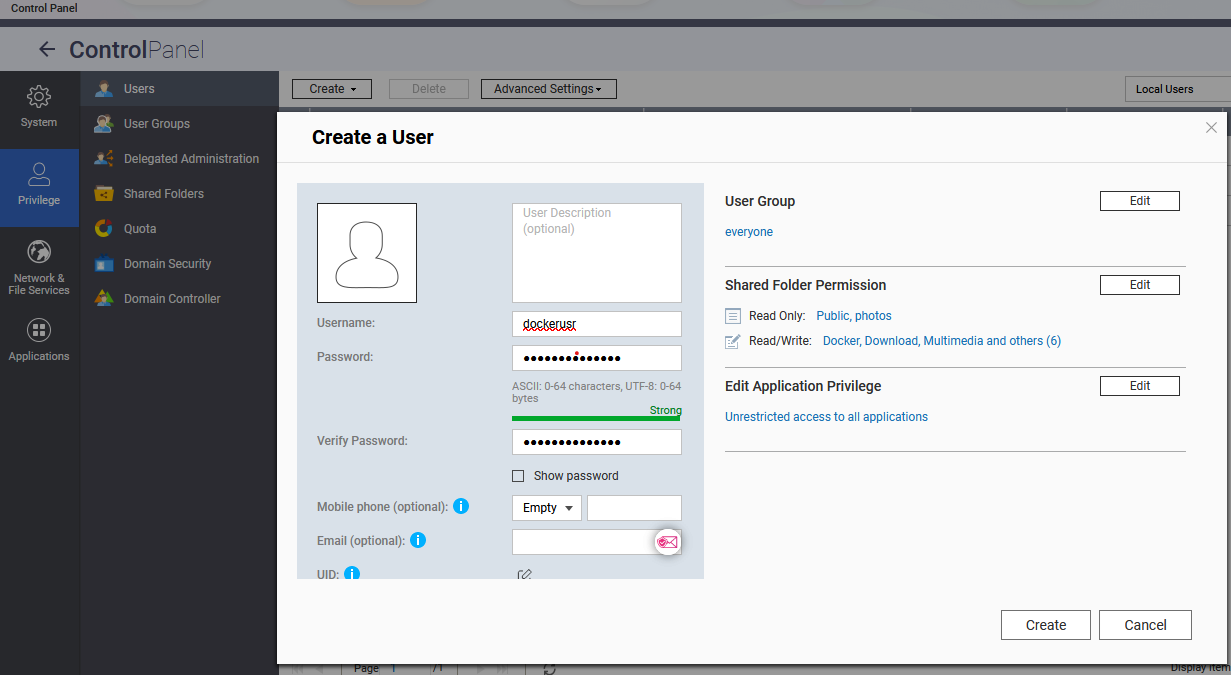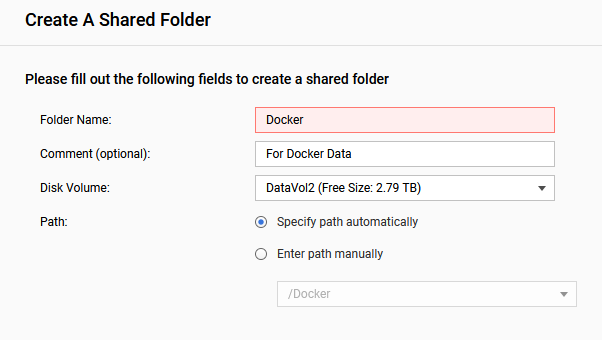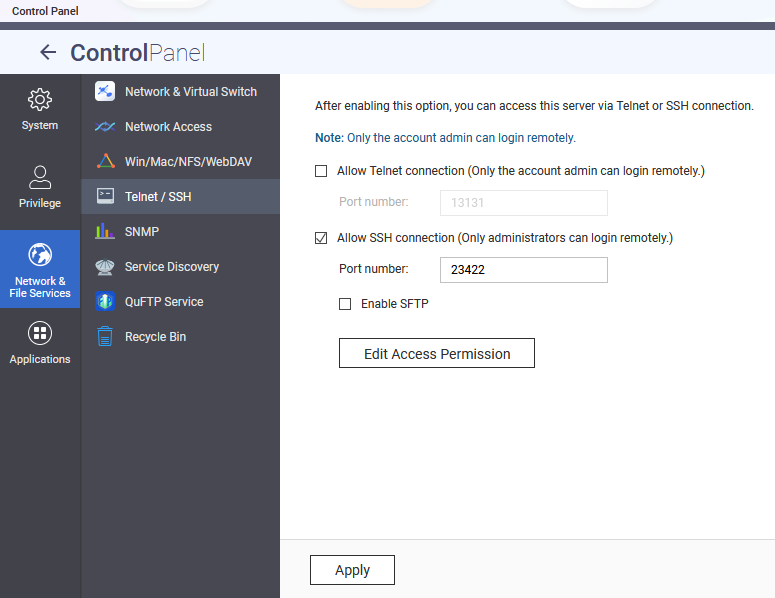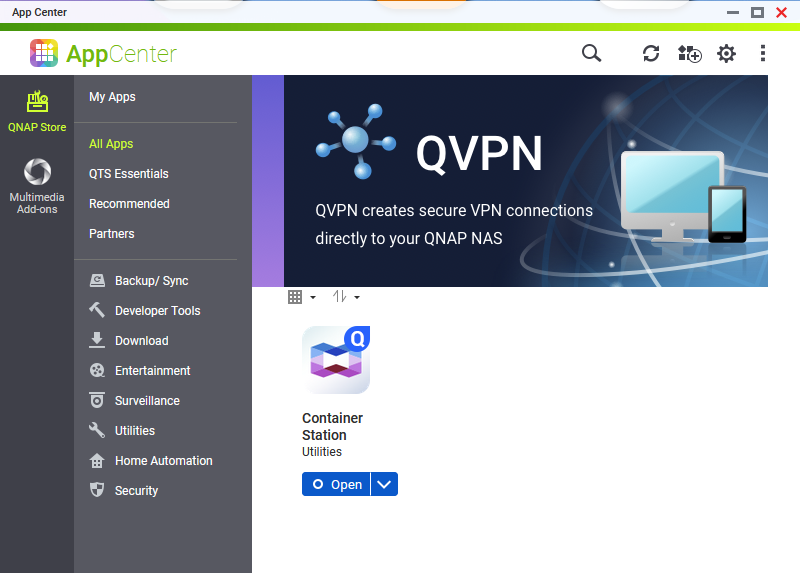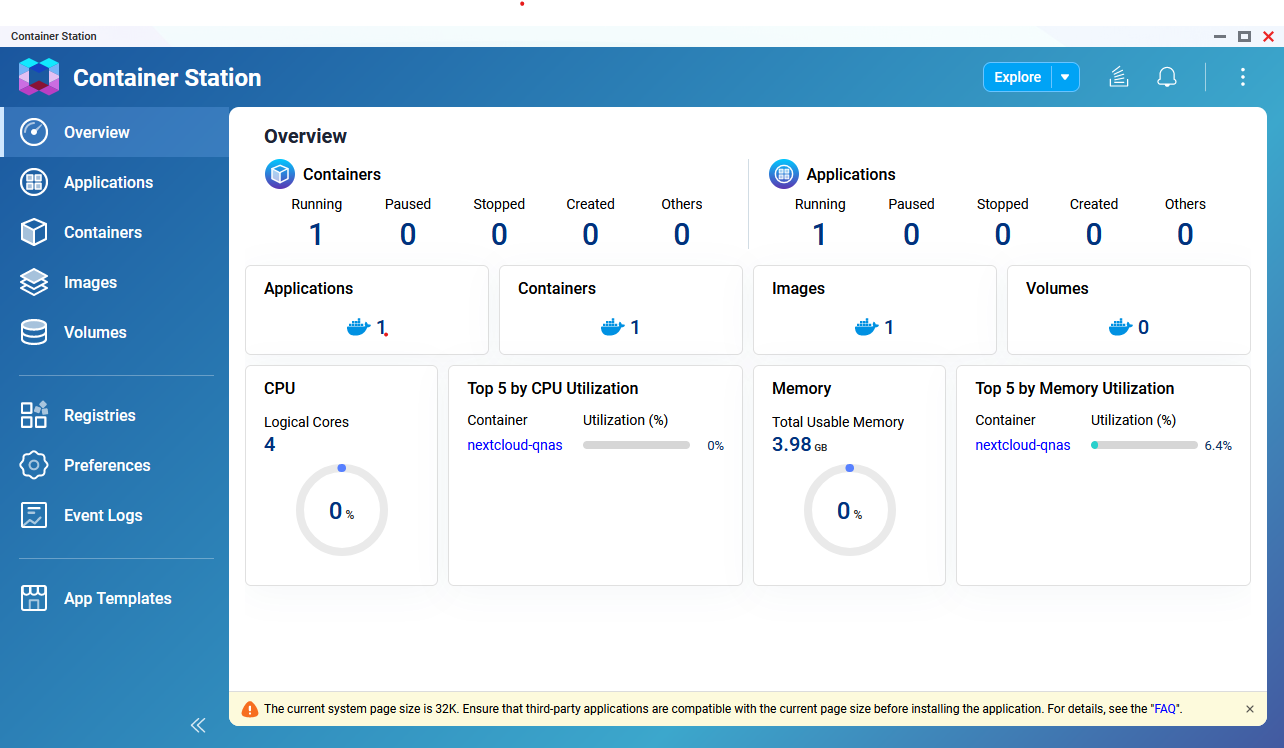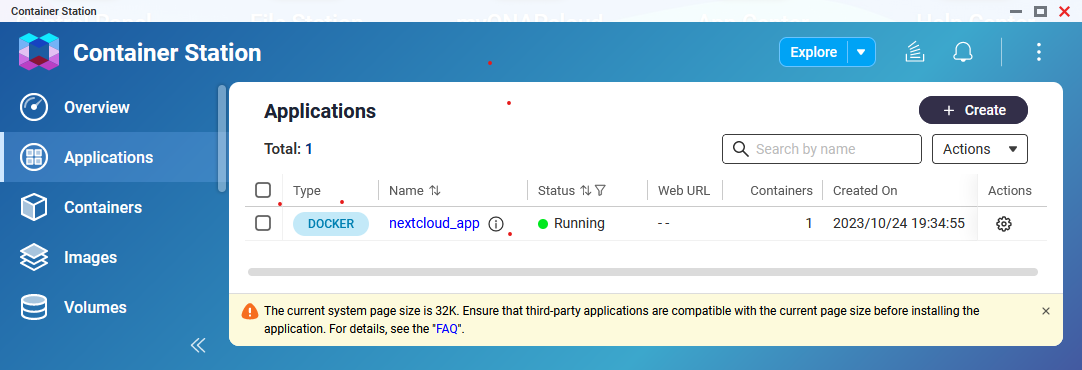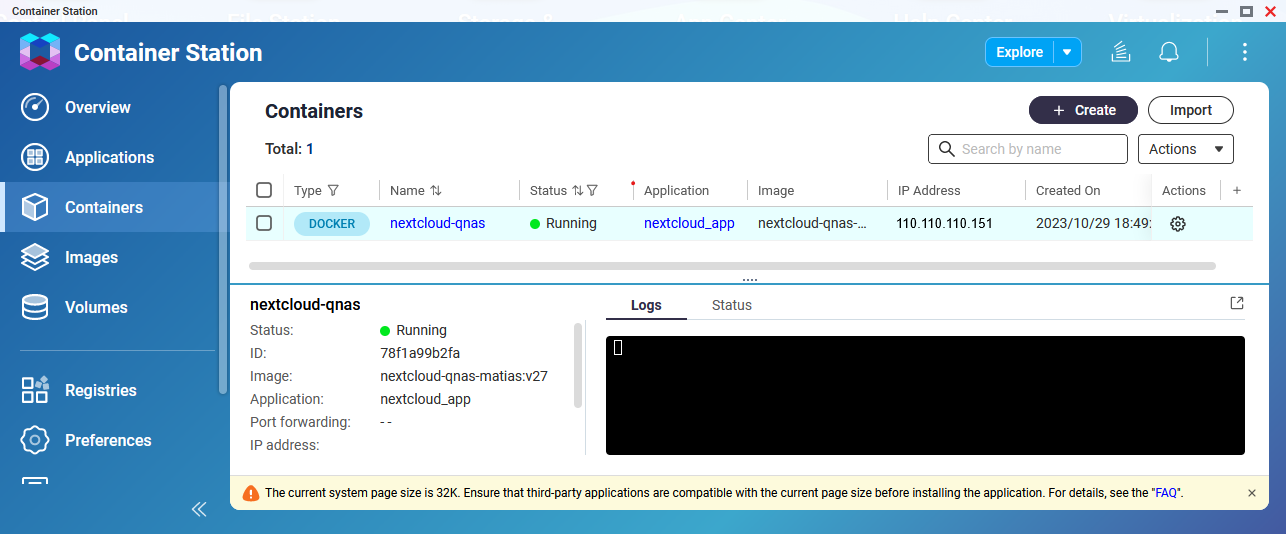Setting up Nextcloud application on a QNAP NAS
In this article, you’ll find everything you need to set up the Nextcloud application on a QNAP NAS using the QNAP Container Station application and, more specifically, Docker.
The set up is specific to the QNAP NAS of the TS-x31P3 Series which has a constraint limiting the use of Docker images in general and consequently blocking the use of the Nextcloud AIO image.
What’s a NAS
A NAS (Network Attached Storage) is a network storage server that stores, backs up, shares, secures and facilitates access to files (photos, videos, music, documents), as well as running applications to add more services (vpn, sftp, web server, etc.).
What’s Nexcloud
Nextcloud is a open source software offering a platform for file storage and sharing services as well as online applications.
Objective
The objective of this approach is to be able to have a private cloud (based on Nextcloud application) allowing the whole family to store, share and manage their data while using an existing QNAP NAS.
The Nextcloud application must be accessible locally using the following HTTPS address: https://110.110.110.151
Note: To have access to the Nextcloud application from Internet, you’ll need to add a NAT rule on your router or Internet box to redirect traffic from ports 80 and 443 to the address 110.110.110.151
Constraints specific to QNAP NAS
The specific QNAP NAS constraint of the TS-x31P3 Series is as follows:
- This NAS has an ARM v7 processor but the QNAP Container Station application has been modified to implement a page size of 32k instead of the default
The majority of existing Docker images don’t work, including Nextcloud AIO (which is Nextcloud’s recommended Docker image).
The error message displayed is :
/bin/sh: error while loading shared libraries: libc.so.6: ELF load command address/offset not page-aligned
QNAP NAS specification
- OS : QTS 5.X
- CPU : Quad-Core ARM Cortex-A15
- Memory : 4GB
- IP Static : 110.110.110.110
Process
We’ll be using the following components:
- QNAP Container Station application (Docker and Docker Compose)
- Nextcloud v27 application (archive)
- A static IP for Nextcloud access (110.110.110.151)
The steps are as follows:
- Create a specific user for Docker
- Create a shared directory for Docker
- Enable SSH access on QNAP NAS
- Install QNAP Container Station application
- SSH connection to QNAP NAS
- Create a Dockerfile
- Creating a Docker Compose file
- Create Nextcloud application configuration files
- Creation of an initialization script for the Nextcloud application
- Creation of a configuration file for all environment variables
- Set up a startup script on the QNAP NAS
Details
Create a specific user for Docker
Create a specific user for Docker to limit rights on all QNAP NAS components and services:
- Go to
Main Menu > ControlPanel > Privilege > Users - Click on the
Createbutton, then on theCreate a Useroption - Fill in the form and choose the name (username) dockeruser
- Click on the
Createbutton
Note: Save the PUID (e.g. 501) and PGID (e.g. 100), as these will be required for the rights of the Docker container containing the Nextcloud application.
Create a shared directory for Docker
To create a specific shared directory for the data and configuration files of the Docker container containing the Nextcloud application, follow these steps:
- Go to
Main Menu > ControlPanel > Privilege > Shared Folders - Click on the
Createbutton, then on theCreate A Shared Folderoption - Fill in the details and click on the
Nextbutton- Folder Name : Folder name
- Comment : Comment for the directory
- Disk Volume : Disk on which the folder will be created
- Path: Directory path
- In the Configure access privileges for users window, select the
RW(read & write) option for your administration user and for the dockeruser user, and click on theNextbutton - In the Properties window, select the desired options and click on the
Finishbutton
Enable SSH access on QNAP NAS
To be able to connect to the QNAP NAS via SSH, you must first activate the service by following the steps below:
- Go to
Main Menu > ControlPanel > Network & File Services > Telnet / SSH - Check the
Allow SSH connectionoption and enter the desired port number - Click on the
Applybutton
Note: In our case, we’ll use port 23422 for SSH access.
Install QNAP Container Station application
To use Docker on the QNAP NAS, you need to install the QNAP Container Station application, following these steps:
- Go to
Main Menu > App Center > QNAP Store > All Apps - Find the Container Station (Utilities) application and click on the
+ Installoption
Note: A shortcut named Container Station should be present on the home page of your QNAP NAS.
SSH connection to QNAP NAS
To connect to the QNAP NAS via SSH, simply use the following command: ssh <useradmin>@<ip NAS QNAP> -p <port>
In our case, the command would be: ssh admin@110.110.110.110 -p 23422
Let’s take this opportunity to create the first directories needed for Docker and the Docker container containing the Nextcloud application
- Go to the Docker shared directory:
cd /share/Docker - Create the nextcloud directory, which will store all data associated with the Nextcloud application:
mkdir /share/Docker/nextcloud - Create the scripts directory, which will store all the scripts and configuration files needed to build the Docker image and container containing the Nextcloud application:
mkdir /share/Docker/scripts
Create a Dockerfile
To set up the Nextcloud application on the QNAP NAS, we’re going to create the required elements.
Creating the directories needed for the Docker image
We’re going to create an nextcloud_app directory in which we’ll put all the elements needed to build the Docker image containing the Nextcloud application :
- Create an nextcloud_app directory:
mkdir /share/Docker/scripts/nextcloud_app - Create a config subdirectory to store all the configuration files required for the Nextcloud application:
mkdir /share/Docker/scripts/nextcloud_app/config
Create a Dockerfile
Create a file named Dockerfile in the directory /share/Docker/scripts/nextcloud_app.
The contents of the file Dockerfile :
1# Based on ubuntu image
2FROM ubuntu:22.04
3
4# Default value
5ARG build_TZ=Europe/Paris
6ARG build_PUID=501
7ARG build_PGID=100
8
9# Config environment
10ENV TZ=$build_TZ
11ENV DEBIAN_FRONTEND noninteractive
12ENV PUID=$build_PUID
13ENV PGID=$build_PGID
14
15# Work directory
16WORKDIR /
17
18# Update Ubuntu system
19RUN apt-get update -y && apt-get upgrade -y
20
21# Install tools (apache2, mariadb and php)
22RUN apt-get install sudo vim wget cron curl ffmpeg apache2 mariadb-server libapache2-mod-php \
23php-gd php-mysql php-curl php-mbstring php-intl php-gmp php-bcmath php-xml php-imagick php-zip \
24php-bz2 php-ldap php-smbclient php-imap php-apcu -y
25
26# Clean APT cache
27RUN apt-get clean
28RUN rm -rf /var/lib/apt/lists/*
29
30# Install Nextcloud in the folder /var/www
31RUN wget https://download.nextcloud.com/server/releases/latest-27.tar.bz2 -O /tmp/nextcloud-27.tar.bz2
32RUN tar -xjvf /tmp/nextcloud-27.tar.bz2 -C /tmp
33RUN cp -r /tmp/nextcloud /var/www
34RUN chown -R www-data:www-data /var/www/nextcloud
35
36# Copy the template nextcloud config files for run_nextcloud.sh later use
37RUN cp -r /tmp/nextcloud/config /tmp/nextcloud_config
38
39# Clean nextcloud temporary folder
40RUN rm -rf /tmp/nextcloud
41RUN rm /tmp/nextcloud-27.*
42
43# Manage SSL certificate
44RUN openssl req -x509 -nodes -days 365 -newkey rsa:2048 -keyout /etc/ssl/private/apache-selfsigned.key -out /etc/ssl/certs/apache-selfsigned.crt \
45-subj /C=FR/ST=France/L=Paris/O=NAS/OU=Nextcloud/CN=nas@nas.nas
46
47# Create specific folder
48RUN mkdir /scripts
49
50# Copy config files
51COPY ./config /config
52# Prepare execution of the run_nextcloud.sh script
53RUN chmod +x /config/run_nextcloud.sh
54
55# Configuration Crontab
56RUN echo exit 0 > /usr/sbin/policy-rc.d
57RUN echo "*/5 * * * * php -f /var/www/nextcloud/cron.php" | crontab -u www-data -
58
59# Expose ports for Nextcloud application
60EXPOSE 80
61EXPOSE 443
62EXPOSE 3478
63
64# Define Entrypoint to execute the run_nextcloud.sh script
65ENTRYPOINT ["bash","/config/run_nextcloud.sh",">","/var/log/nextcloud/run_nextcloud.log"]
Creating a Docker Compose file
To make it easier to use Docker to build the Nextcloud application, we’re going to use Docker Compose to create a file named docker-compose.yml in the /share/Docker/scripts/nextcloud_app directory.
This file will enable us to define the build of the Docker image and the Docker network to be used by the Docker container containing the Nextcloud application.
The contents of the file docker-compose.yml :
1version: "3.7"
2
3services:
4 # Nextcloud application
5 nextcloud:
6 image: nextcloud-qnas-img:v27
7 # Build configuration
8 build:
9 context: .
10 dockerfile: Dockerfile
11 # Default argument for the build
12 args:
13 build_PUID : 501
14 build_PGID : 100
15 build_TZ : Europe/Paris
16 # Name of the application for QNAP Container Station
17 container_name: nextcloud-qnas
18 # Define the Static IP from QNET Network
19 networks:
20 qnet-static-eth0:
21 ipv4_address: 110.110.110.151
22 # Define the Env file to initialise environment variable for the container
23 env_file:
24 - ./config/.env
25 # Define all the volume to store the data and logs into the shared folder (and not into the container)
26 volumes:
27 - /share/Docker/nextcloud/nc_data:/var/www/nextcloud/data
28 - /share/Docker/nextcloud/nc_apps:/var/www/nextcloud/apps
29 - /share/Docker/nextcloud/db_data:/var/lib/mysql
30 - /share/Docker/nextcloud/nc_log:/var/log/nextcloud
31 - /share/Docker/nextcloud/db_log:/var/log/mysql
32 # Define the exposed port
33 ports:
34 - 80:80
35 - 443:443
36 - 3478:3478
37 # Don't restart the container only if we manually stop it
38 restart: unless-stopped
39
40# Define the network based en NAS QNAP interfaces
41networks:
42 qnet-static-eth0 :
43 driver: qnet
44 driver_opts:
45 iface: "eth0"
46 ipam:
47 driver: qnet
48 options:
49 iface: "eth0"
50 config:
51 - subnet: 110.110.110.0/24
52 gateway: 110.110.110.1
Note on volumes:
- The
/share/Docker/nextcloud/nc_datadirectory will contain all Nextcloud application user data - The
/share/Docker/nextcloud/nc_appsdirectory will contain all the Nextcloud application’s internal applications - The
/share/Docker/nextcloud/db_datadirectory will contain all the MariaDB database data used by the Nextcloud application - The
/share/Docker/nextcloud/nc_logdirectory will contain all Nextcloud application logs - The
/share/Docker/nextcloud/db_logdirectory will contain all logs from the MariaDB database used by the Nextcloud application
Note: The objective is to keep the data from the mariaDB database and the Nextcloud application in the shared directory, to make backups easier and to be able to dissociate the data from the container.
Create Nextcloud application configuration files
In order to configure the services required by the Nextcloud application when running the Docker container, we’ll prepare the following configuration files:
I. For the Apache2 service :
- Create the configuration directory
mkdir /share/Docker/scripts/nextcloud_app/config/apache2 - Create the configuration file nextcloud.conf in the created directory
The contents of the file nextcloud.conf :
1<VirtualHost *:80>
2 ServerName ${NC_HOSTNAME}
3 Redirect permanent / https://${NC_HOSTNAME}/
4</VirtualHost>
5
6<VirtualHost *:443>
7 ServerName ${NC_HOSTNAME}
8 DocumentRoot ${ROOT_NC}/
9
10 Alias / "${ROOT_NC}/"
11
12 SSLEngine on
13 SSLCertificateFile /etc/ssl/certs/apache-selfsigned.crt
14 SSLCertificateKeyFile /etc/ssl/private/apache-selfsigned.key
15
16 <Directory ${ROOT_NC}/>
17 Options +FollowSymlinks
18 AllowOverride All
19 Require all granted
20 <IfModule mod_dav.c>
21 Dav off
22 </IfModule>
23 SetEnv HOME ${ROOT_NC}
24 SetEnv HTTP_HOME ${ROOT_NC}
25 SetEnv HTTPS_HOME ${ROOT_NC}
26 </Directory>
27
28 ErrorLog ${APACHE_LOG_DIR}/error.log
29 CustomLog ${APACHE_LOG_DIR}/access.log combined
30
31</VirtualHost>
III. For the MariaDB service :
- Create the configuration directory
mkdir /share/Docker/scripts/nextcloud_app/config/mariadb - Create the 50-server.conf configuration file in the directory you’ve created, using the desired template and modifying the line starting with
datadirwith the following linedatadir = ${ROOT_DB_DATA}
III. For the Nextcloud application :
- Create the
mkdir /share/Docker/scripts/nextcloud_app/config/nextcloudconfiguration directory. - Create configuration files named autoconfig.php and docker.config.php in the created directory to automatically configure the Nextcloud application on the first run
The contents of the file autoconfig.php :
1<?php
2$AUTOCONFIG = array(
3 "dbtype" => "mysql",
4 "dbname" => "${MYSQL_DATABASE}",
5 "dbuser" => "${MYSQL_USER}",
6 "dbpass" => "${MYSQL_PASSWORD}",
7 "dbhost" => "localhost",
8 "dbtableprefix" => "oc_",
9 "adminlogin" => "admin",
10 "adminpass" => "${NC_ADMIN_PASSWORD}",
11 "directory" => "${ROOT_NC_DATA}",
12 "trusted_domains" =>
13 array (
14 0 => "${STATIC_IP}",
15 1 => "${NC_HOSTNAME}",
16 ),
17);
The contents of the file docker.config.php :
1<?php
2$CONFIG = array (
3 'overwriteprotocol' => 'https',
4 'overwritewebroot' => '/',
5 'overwrite.cli.url' => 'https://${NC_HOSTNAME}',
6 'htaccess.RewriteBase' => '/',
7 'mysql.utf8mb4' => true,
8 'default_language' => 'fr',
9 'force_language' => 'fr',
10 'default_locale' => 'fr_FR',
11 'default_phone_region' => 'FR',
12 'force_locale' => 'fr_FR',
13 'knowledgebaseenabled' => true,
14 'allow_user_to_change_display_name' => true,
15 'auth.bruteforce.protection.enabled' => true,
16 'auth.bruteforce.protection.testing' => false,
17 'ratelimit.protection.enabled' => true,
18 'auth.webauthn.enabled' => true,
19 'auth.storeCryptedPassword' => true,
20 'lost_password_link' => 'disabled',
21 'mail_domain' => '${MAIL_DOMAINE}',
22 'updatechecker' => true,
23 'updater.server.url' => 'https://updates.nextcloud.com/updater_server/',
24 'updater.release.channel' => 'stable',
25 'has_internet_connection' => true,
26 'connectivity_check_domains' => [
27 'www.nextcloud.com',
28 'www.startpage.com',
29 'www.eff.org',
30 'www.edri.org'
31 ],
32 'log_type' => 'file',
33 'log_type_audit' => 'file',
34 'logfile' => '${ROOT_NC_LOG}/nextcloud.log',
35 'logfile_audit' => '${ROOT_NC_LOG}/audit.log',
36 'logfilemode' => 0640,
37 'loglevel' => 2,
38 'loglevel_frontend' => 2,
39 'syslog_tag' => 'Nextcloud',
40 'syslog_tag_audit' => 'Nextcloud',
41 'logdateformat' => 'F d, Y H:i:s',
42 'logtimezone' => '${TZ}',
43 'customclient_desktop' =>
44 'https://nextcloud.com/install/#install-clients',
45'customclient_android' =>
46 'https://play.google.com/store/apps/details?id=com.nextcloud.client',
47'customclient_ios' =>
48 'https://itunes.apple.com/us/app/nextcloud/id1125420102?mt=8',
49'customclient_ios_appid' =>
50 '1125420102',
51 'defaultapp' => 'dashboard,files',
52 'appstoreenabled' => true,
53 'apps_paths' => [
54 [
55 'path'=> OC::$SERVERROOT . '/apps',
56 'url' => '/apps',
57 'writable' => true,
58 ],
59 ],
60 'enable_previews' => false,
61 'memcache.local' => '\OC\Memcache\APCu',
62);
IV. For the PHP service :
- Create the configuration directory
mkdir /share/Docker/scripts/nextcloud_app/config/php - Create a configuration file named 20-pdo_mysql.ini in the created directory
The contents of the file 20-pdo_mysql.ini:
1; configuration for php mysql module
2; priority=20
3extension=pdo_mysql.so
4
5[mysql]
6mysql.allow_local_infile=On
7mysql.allow_persistent=On
8mysql.cache_size=2000
9mysql.max_persistent=-1
10mysql.max_links=-1
11mysql.default_port=3306
12mysql.default_socket=/var/lib/mysql/mysql.sock
13mysql.default_host=localhost
14mysql.connect_timeout=60
15mysql.trace_mode=Off
Creation of an initialization script for the Nextcloud application
In order to initialize the Nextcloud application when the container is executed, we’ll set up the run_nextcloud.sh script in the /share/Docker/scripts/nextcloud_app/config directory.
The contents of the file run_nextcloud.sh :
1#!/bin/sh
2
3# ENV
4ROOT_CONF="/config"
5
6# Check one environment variable (if .env is ok)
7if [ -z "${ROOT_DB_DATA}" ]; then
8 echo "$(date +"%Y-%m-%d %H:%M:%S") - Error - Environment variable issues"
9 exit 1
10fi
11
12
13# Check data folder to do the initialisation only if one or more folders are emppty
14CHECK_FOLDER_MARIADB=$(ls "${ROOT_DB_DATA}" | wc -l)
15CHECK_FOLDER_NC=$(ls "${ROOT_NC_DATA}" | wc -l)
16CHECK_FOLDER_NC_CONF=$(ls "${ROOT_NC_CONF}" | wc -l)
17if [ $CHECK_FOLDER_MARIADB -eq 0 ] || [ $CHECK_FOLDER_NC -eq 0 ] || [ $CHECK_FOLDER_NC_CONF -eq 0 ]; then
18
19 echo "$(date +"%Y-%m-%d %H:%M:%S") - Info - Init Nextcloud"
20
21 # Delete old data
22 echo "$(date +"%Y-%m-%d %H:%M:%S") - Info - Delete existing Data"
23 rm -rf $ROOT_DB_DATA/*
24 rm -rf $ROOT_NC_DATA/*
25 rm -rf $ROOT_NC_CONF/*
26
27 # Copy config files
28 echo "$(date +"%Y-%m-%d %H:%M:%S") - Info - Copy config files"
29 # Mariadb
30 cat $ROOT_CONF/mariadb/50-server.cnf | sed 's|${ROOT_DB_DATA}|'"${ROOT_DB_DATA}"'|g' > /etc/mysql/mariadb.conf.d/50-server.cnf
31 # Apache2 and PHP
32 echo "apc.enable_cli = 1" >> /etc/php/8.1/apache2/php.ini
33 cat $ROOT_CONF/php/20-pdo_mysql.ini > /etc/php/8.1/apache2/conf.d/20-pdo_mysql.ini
34 cat $ROOT_CONF/apache2/nextcloud.conf | sed 's|${NC_HOSTNAME}|'"${NC_HOSTNAME}"'|g' \
35 | sed 's|${ROOT_NC}|'"${ROOT_NC}"'|g' \
36 > /etc/apache2/sites-available/nextcloud.conf
37 # Nextcloud
38 cp /tmp/nextcloud_config/* $ROOT_NC_CONF/.
39 cat $ROOT_CONF/nextcloud/autoconfig.php | sed 's|${NC_HOSTNAME}|'"${NC_HOSTNAME}"'|g' \
40 | sed 's|${ROOT_NC_DATA}|'"${ROOT_NC_DATA}"'|g' \
41 | sed 's|${MYSQL_DATABASE}|'"${MYSQL_DATABASE}"'|g' \
42 | sed 's|${MYSQL_USER}|'"${MYSQL_USER}"'|g' \
43 | sed 's|${MYSQL_PASSWORD}|'"${MYSQL_PASSWORD}"'|g' \
44 | sed 's|${STATIC_IP}|'"${STATIC_IP}"'|g' \
45 | sed 's|${NC_ADMIN_PASSWORD}|'"${NC_ADMIN_PASSWORD}"'|g' \
46 > ${ROOT_NC_CONF}/autoconfig.php
47 cat $ROOT_CONF/nextcloud/docker.config.php | sed 's|${NC_HOSTNAME}|'"${NC_HOSTNAME}"'|g' \
48 | sed 's|${MAIL_DOMAINE}|'"${MAIL_DOMAINE}"'|g' \
49 | sed 's|${ROOT_LOG}|'"${ROOT_LOG}"'|g' \
50 | sed 's|${TZ}|'"${TZ}"'|g' \
51 | sed 's|${ROOT_NC_LOG}|'"${ROOT_NC_LOG}"'|g' \
52 | sed 's|${ROOT_NC_APPS}|'"${ROOT_NC_APPS}"'|g' \
53 > ${ROOT_NC_CONF}/docker.config.php
54
55 # Manage right on config files
56 echo "$(date +"%Y-%m-%d %H:%M:%S") - Info - Manage right on config files"
57 chmod 644 /etc/mysql/mariadb.conf.d/50-server.cnf
58 chmod 644 /etc/php/8.1/apache2/conf.d/20-pdo_mysql.ini
59 chmod 644 /etc/php/8.1/apache2/php.ini
60 chmod 644 /etc/apache2/sites-available/nextcloud.conf
61 chmod 644 ${ROOT_NC_CONF}/*
62
63 # Init MariaDB service
64 echo "$(date +"%Y-%m-%d %H:%M:%S") - Info - MariasDB : Install DB (mysql)"
65 mariadb-install-db --user=mysql
66 if [ $? -ne 0 ]; then echo "$(date +"%Y-%m-%d %H:%M:%S") - Error - MariasDB Install"; exit 1 ; fi
67
68 # Start MariaDB service
69 echo "$(date +"%Y-%m-%d %H:%M:%S") - Info - MariasDB : Start service"
70 service mariadb start
71 if [ $? -ne 0 ]; then echo "$(date +"%Y-%m-%d %H:%M:%S") - Error - MariasDB Start"; exit 1 ; fi
72
73 # Create nextcloud user into MariaDB
74 QRY_SQL="CREATE USER IF NOT EXISTS '${MYSQL_USER}'@'localhost' IDENTIFIED BY '${MYSQL_PASSWORD}';
75 CREATE DATABASE IF NOT EXISTS ${MYSQL_DATABASE} CHARACTER SET utf8mb4 COLLATE utf8mb4_general_ci;
76 GRANT ALL PRIVILEGES ON ${MYSQL_DATABASE}.* TO '${MYSQL_USER}'@'localhost';
77 FLUSH PRIVILEGES;"
78
79 echo "$(date +"%Y-%m-%d %H:%M:%S") - Info - MariasDB : Create user et database"
80 mariadb -u root -e "${QRY_SQL}"
81 if [ $? -ne 0 ]; then echo "$(date +"%Y-%m-%d %H:%M:%S") - Error - MariasDB exec QRY"; exit 1 ; fi
82
83
84 # Init Apache2 service
85 echo "$(date +"%Y-%m-%d %H:%M:%S") - Info - Apache2 : Init conf"
86 echo "ServerName ${STATIC_IP}" >> /etc/apache2/apache2.conf
87 a2ensite nextcloud.conf
88 a2enmod rewrite headers env dir mime ssl
89
90 # Start Apache2 service
91 echo "$(date +"%Y-%m-%d %H:%M:%S") - Info - Apache2 : Start service"
92 service apache2 start
93 if [ $? -ne 0 ]; then echo "$(date +"%Y-%m-%d %H:%M:%S") - Error - apache2 service start"; exit 1 ; fi
94
95 # Manage folders rights
96 echo "$(date +"%Y-%m-%d %H:%M:%S") - Info - Manage folders chown"
97 chown -R www-data:www-data ${ROOT_NC}
98 chown -R www-data:www-data ${ROOT_NC_DATA}
99 chown -R www-data:www-data ${ROOT_NC_CONF}
100 chown -R www-data:www-data ${ROOT_NC_APPS}
101 chown -R mysql:mysql ${ROOT_DB_DATA}
102 chmod -R 766 ${ROOT_NC_LOG}
103 chmod -R 766 ${ROOT_DB_LOG}
104 chown -R www-data:www-data ${ROOT_NC_LOG}
105 chown -R www-data:www-data ${ROOT_DB_LOG}
106
107
108 # Execute Nextcloud for the first time with HTTPS (initialize admin user and data folder)
109 openssl s_client -showcerts -connect ${NC_HOSTNAME}:443 </dev/null | sed -n -e '/-.BEGIN/,/-.END/ p' > /tmp/nextcloud.pem
110 curl --cacert /tmp/nextcloud.pem https://${NC_HOSTNAME}
111 rm /tmp/nextcloud.pem
112
113 # Start Cron service
114 service cron start
115 if [ $? -ne 0 ]; then echo "$(date +"%Y-%m-%d %H:%M:%S") - Error - cron service start"; exit 1 ; fi
116
117else
118 # If init already done : Start services
119 service mariadb start
120 if [ $? -ne 0 ]; then echo "$(date +"%Y-%m-%d %H:%M:%S") - Error - mariadb service start"; exit 1 ; fi
121 service apache2 start
122 if [ $? -ne 0 ]; then echo "$(date +"%Y-%m-%d %H:%M:%S") - Error - apache2 service start"; exit 1 ; fi
123 service cron start
124 if [ $? -ne 0 ]; then echo "$(date +"%Y-%m-%d %H:%M:%S") - Error - cron service start"; exit 1 ; fi
125
126fi
127
128# Infinite loop to keep service up
129while [ 1 ]; do
130 sleep 300
131
132 # Check Apache2 service
133 CHECK_APACHE=$(service apache2 status | grep 'is running' | wc -l)
134 if [ "$CHECK_APACHE" != "1" ]; then
135 echo "$(date +"%Y-%m-%d %H:%M:%S") - Info - Restart apache2 service"
136 service apache2 start
137 CHECK_APACHE_2=$(service apache2 status | grep 'is running' | wc -l)
138 if [ "$CHECK_APACHE_2" != "1" ]; then
139 echo "$(date +"%Y-%m-%d %H:%M:%S") - Error - Service apache2 KO"
140 exit 1
141 fi
142 fi
143
144 # Check MariaDB service
145 CHECK_MARIADB=$(service mariadb status | grep 'Uptime' | wc -l)
146 if [ "$CHECK_MARIADB" != "1" ]; then
147 echo "$(date +"%Y-%m-%d %H:%M:%S") - Info - Restart mariadb service"
148 service mariadb start
149 CHECK_MARIADB_2=$(service mariadb status | grep 'Uptime' | wc -l)
150 if [ "$CHECK_MARIADB_2" != "1" ]; then
151 echo "$(date +"%Y-%m-%d %H:%M:%S") - Error - Service mariadb KO"
152 exit 1
153 fi
154 fi
155
156done
157
158exit 0
Creation of a configuration file for all environment variables
In order to finalize the creation of the Docker image, we need to set up an .env file to centralize all the environment variables required by the container and, more specifically, by the run_nextcloud.sh initialization script.
This environment file is defined in the docker-compose.yml file.
The .env file must be created in the /share/Docker/scripts/nextcloud_app/config directory.
The contents of the file .env : (replacing the values required for your environment))
1PUID=501
2PGID=100
3ROOT_DB_DATA=/var/lib/mysql
4ROOT_NC=/var/www/nextcloud
5ROOT_NC_DATA=/var/www/nextcloud/data
6ROOT_NC_CONF=/var/www/nextcloud/config
7ROOT_NC_LOG=/var/log/nextcloud
8ROOT_DB_LOG=/var/log/mysql
9ROOT_NC_APPS=/var/www/nextcloud/apps
10NC_HOSTNAME=<hostname (ex: nextcloud.nas.nas)>
11MYSQL_DATABASE=nextcloud
12MYSQL_USER=<nextcloud username for mariadb>
13MYSQL_PASSWORD=<nextcloud user password for mariadb>
14STATIC_IP=110.110.110.151
15MAIL_DOMAINE=nas@nas.nas
16TZ=Europe/Paris
17NC_ADMIN_PASSWORD=<nextcloud admin password>
Set up a startup script on the QNAP NAS
In order to start the Docker container of the Nextcloud application at the QNAP NAS startup :
- Go to
Main Menu > ControlPanel > System > Hardware - In the
Generaltab, check theRun user defined processes during startupoption - Connect to the QNAS NAS via SSH with an administrator account:
ssh <user>@<ip> -p <port> - Run the follow commands to mount the directory
/tmp/config
1ubiattach -m 6 -d 2
2/bin/mount -t ubifs ubi2:config /tmp/config
- Create the file
/tmp/config/autorun.shwith the content as follow :
1#!/bin/sh
2cd /share/Docker/scripts/nextcloud_app
3docker compose up -d
- Run the following commands to be able to run the file
/tmp/config/autorun.shand unmount he directory/tmp/config
1chmod +x /tmp/config/autorun.sh
2umount /tmp/config
3ubidetach -m 6
Run the Nextcloud application
The steps for manually running the Nextcloud application are as follows:
- Connect SSH to the QNAP NAS with an administrator account:
ssh <user>@<ip> -p <port> - Go to the directory containing the Docker image elements:
cd /share/Docker/scripts/nextcloud_app - Run the following Docker Compose command:
docker compose up -d - Wait a few seconds/minutes and check that the container is running correctly by connecting to the Nextcloud application
https://110.110.110.151
You can check that the container is running correctly by checking the information in the QNAP Container Station application, or by using the usual docker commands (stats, logs, ps, …).
Docker commands
Some commands for using Docker :
docker build -t nextcloud-qnas-img:v27 .: Builds the image from the Dockerfile in the current directory.docker build -t nextcloud-qnas-img:v27 . --build-arg build_TZ=Europe/Paris --build-arg build_PUID=501 --build-arg build_PGID=100: Build command with argument
docker ps: List of running containersdocker ps -a: List of all existing containersdocker stats: Statistics on running container usagedocker logs nextcloud-qnas: Container log message (standard output)docker create -i -t -v /share/Docker/nextcloud/...:/... -v ... --name nextcloud-qnas nextcloud-qnas-img:v27: Create an nextcloud-qnas container from the nextcloud-qnas-img:v27 imagedocker container start -a -i nextcloud-qnas: Start a container by accessing the console directlydocker rm nextcloud-qnas: Delete the container
If you need to manually recreate the QNAP NAS network for Docker :
1# Create dhcp network
2docker network create -d qnet --opt=iface=eth0 --ipam-driver=qnet --ipam-opt=iface=eth0 qnet-dhcp-eth0
3
4# Create static network
5docker network create -d qnet --opt=iface=eth0 --ipam-driver=qnet --ipam-opt=iface=eth0 \
6 --subnet=110.110.110.0/24 --gateway=110.110.110.1 qnet-static-eth0
Some commands for using Docker Compose : (You need to be in the directory containing the docker-compose.yaml file)
docker compose build --build-arg TZ=Europe/Paris --build-arg PUID=501 --build-arg PGID=100: Allows build to be performed in the same way as the Docker commanddocker compose up -d: Create and start defined containersdocker compose down: Stop and delete defined containersdocker compose start: Start defined containersdocker compose stop: Stop defined containers


